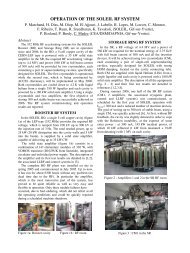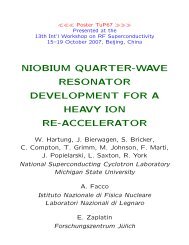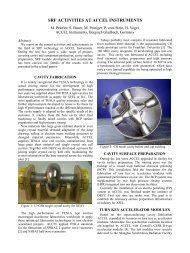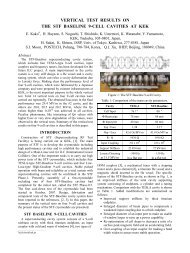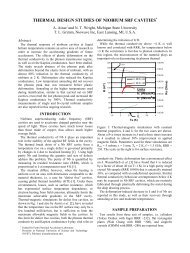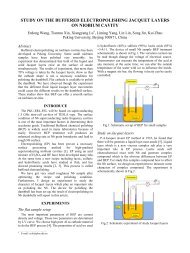on the dependence of the q-value on the accelerating gradient for ...
on the dependence of the q-value on the accelerating gradient for ...
on the dependence of the q-value on the accelerating gradient for ...
Create successful ePaper yourself
Turn your PDF publications into a flip-book with our unique Google optimized e-Paper software.
ON THE DEPENDENCE OF THE Q-VALUE ON THE ACCELERATING<br />
GRADIENT FOR SUPERCONDUCTING CAVITIES<br />
W. Weingarten, CERN, Geneva, Switzerland #<br />
Abstract<br />
The per<strong>for</strong>mance <strong>of</strong> niobium superc<strong>on</strong>ducting cavities<br />
<strong>for</strong> accelerator applicati<strong>on</strong>s has improved c<strong>on</strong>siderably<br />
over <strong>the</strong> last decade. Individual cavities reach <strong>accelerating</strong><br />
<strong>gradient</strong>s close to <strong>the</strong> <strong>the</strong>oretical limit (about 50 MV/m),<br />
however sometimes at <strong>the</strong> expense <strong>of</strong> a re-treatment<br />
(baking, electro-polishing, rinsing) needed to eliminate an<br />
undesired decrease <strong>of</strong> <strong>the</strong> Q-<strong>value</strong> with <strong>the</strong> field <strong>gradient</strong><br />
(Q-slope, Q-drop). Cures have been developed, but a<br />
generally accepted physical explanati<strong>on</strong> is still missing.<br />
Fur<strong>the</strong>rmore, <strong>for</strong> successful research work <strong>on</strong> materials<br />
o<strong>the</strong>r than niobium, it is <strong>of</strong> utmost importance to<br />
understand better <strong>the</strong> limitati<strong>on</strong>s in <strong>gradient</strong> and Q-<strong>value</strong><br />
<strong>of</strong> superc<strong>on</strong>ducting cavities. The paper presents an<br />
alternative explanati<strong>on</strong> <strong>for</strong> <strong>the</strong> Q-slope and c<strong>on</strong>fr<strong>on</strong>ts it<br />
with experimental results <strong>for</strong> 352 and 1500 MHz cavities.<br />
INTRODUCTION AND SCOPE<br />
The technology <strong>of</strong> superc<strong>on</strong>ducting niobium cavities <strong>for</strong><br />
accelerator applicati<strong>on</strong> has made large progress in <strong>the</strong> last<br />
decade. Accelerating <strong>gradient</strong>s between 5 and 10 MV/m<br />
that were safely obtained in <strong>the</strong> past, as <strong>for</strong> example in <strong>the</strong><br />
Large Electr<strong>on</strong> Positr<strong>on</strong> collider LEP [1], are now<br />
reproducibly surpassed in individual cavities as well as in<br />
prototype cryo-modules such as needed <strong>for</strong> <strong>the</strong> XFEL at<br />
DESY (23.6 MV/m) or <strong>the</strong> Internati<strong>on</strong>al Linear Collider<br />
ILC under design study right now (31.5 MV/m).<br />
This paper is intended to revise earlier and recent<br />
experimental results <strong>on</strong> <strong>the</strong> decrease <strong>of</strong> <strong>the</strong> Q-<strong>value</strong> with<br />
<strong>the</strong> RF field amplitude, <strong>of</strong>ten observed <strong>for</strong><br />
superc<strong>on</strong>ducting <strong>accelerating</strong> cavities.<br />
Although this decrease is observed as well in niobium<br />
cavities manufactured from sheet metal [2], <strong>the</strong> focus <strong>of</strong><br />
<strong>the</strong> paper is directed to niobium film cavities pi<strong>on</strong>eered by<br />
CERN <strong>for</strong> <strong>the</strong> LEP electr<strong>on</strong> positr<strong>on</strong> collider and now<br />
also installed in <strong>the</strong> Large Hadr<strong>on</strong> Collider LHC.<br />
Never<strong>the</strong>less <strong>the</strong> attempt is made to assess <strong>the</strong>se two<br />
technologies (sheet metal and film) under a comm<strong>on</strong><br />
viewpoint.<br />
In fact <strong>the</strong>re are three different regimes where <strong>the</strong> Q-<br />
<strong>value</strong> depends <strong>on</strong> <strong>the</strong> <strong>accelerating</strong> <strong>gradient</strong> or,<br />
equivalently, <strong>the</strong> maximum applied magnetic surface field<br />
amplitude B. In <strong>the</strong> low field regi<strong>on</strong> (B < 20 mT) <strong>the</strong> Q-<br />
<strong>value</strong> may increase with B (low field Q-increase). In <strong>the</strong><br />
intermediate field regi<strong>on</strong> (20-120 mT) <strong>the</strong> Q-<strong>value</strong><br />
decreases, and bey<strong>on</strong>d, incidentally, <strong>the</strong> Q-<strong>value</strong> may<br />
drop even faster. These latter two observati<strong>on</strong>s are named<br />
“Q-slope” and “Q-drop”.<br />
To understand <strong>the</strong> physical mechanism behind <strong>the</strong>se<br />
observati<strong>on</strong>s is not <strong>on</strong>ly <strong>of</strong> academic interest, especially<br />
________________________________________<br />
# wolfgang.weingarten@cern.ch<br />
<strong>for</strong> film cavities. As <strong>the</strong> reas<strong>on</strong> is nei<strong>the</strong>r clear nor<br />
mastered, film cavities are disregarded from being a<br />
serious competitor to sheet metal cavities. N<strong>on</strong>e<strong>the</strong>less,<br />
<strong>the</strong> many assets <strong>of</strong> <strong>the</strong> film technology make it a very<br />
serious candidate <strong>for</strong> large new projects. They include: a<br />
better <strong>the</strong>rmal protecti<strong>on</strong> against quenches; a lower<br />
niobium cost; no need <strong>for</strong> niobium chemistry; revamping<br />
possibility.<br />
POSTULATES<br />
The postulates <strong>of</strong> <strong>the</strong> model presented in this paper are<br />
<strong>the</strong> following:<br />
(i) Niobium metal, whe<strong>the</strong>r produced as a film or from<br />
sheet metal, is inhomogeneous and c<strong>on</strong>sists <strong>of</strong> different<br />
composites, say two <strong>of</strong> <strong>the</strong>m <strong>for</strong> reas<strong>on</strong>s <strong>of</strong> c<strong>on</strong>venience.<br />
The first, filling up <strong>the</strong> smaller volume <strong>of</strong> both, is made<br />
up <strong>of</strong> a weak superc<strong>on</strong>ductor with a smaller lower critical<br />
field B 0 than that <strong>of</strong> pure Nb, called “defects”. They have<br />
a surface density n s0 and a size a much smaller than all<br />
characteristic lengths <strong>of</strong> <strong>the</strong> superc<strong>on</strong>ductor (such as <strong>the</strong><br />
coherence length ξ and penetrati<strong>on</strong> depth λ). The sec<strong>on</strong>d,<br />
filling up <strong>the</strong> larger volume <strong>of</strong> both, c<strong>on</strong>sists <strong>of</strong> niobium<br />
metal, called “bulk”, characterized by a lower critical<br />
field B c1 * , different from that <strong>of</strong> ordinary niobium, and a<br />
coherence lengths ξ determined by <strong>the</strong> mean free paths l<br />
and <strong>the</strong> coherence length ξ 0 in <strong>the</strong> clean limit,<br />
1<br />
ξ<br />
1<br />
1<br />
= + l ξ0<br />
. (1)<br />
(ii) The RF losses are created by <strong>the</strong> transiti<strong>on</strong> <strong>of</strong> <strong>the</strong>se<br />
defects from <strong>the</strong> superc<strong>on</strong>ducting to <strong>the</strong> normal<br />
c<strong>on</strong>ducting state, starting from B 0 , and increasing <strong>the</strong> size<br />
<strong>of</strong> its normal c<strong>on</strong>ducting volume with increasing magnetic<br />
field B. They per<strong>for</strong>m <strong>the</strong> transiti<strong>on</strong> back again into <strong>the</strong><br />
superc<strong>on</strong>ducting state when B decreases again later during<br />
<strong>the</strong> RF cycle. Their inherent c<strong>on</strong>densati<strong>on</strong> energy is<br />
dissipated to <strong>the</strong> helium bath, twice per RF cycle.<br />
THE RF LOSSES ASSOCIATED WITH<br />
THE Q-SLOPE<br />
The phase transiti<strong>on</strong> as described be<strong>for</strong>e is supposed be<br />
<strong>of</strong> sec<strong>on</strong>d order, because niobium is a type II<br />
superc<strong>on</strong>ductor, already when being in elemental <strong>for</strong>m<br />
and <strong>the</strong> more when c<strong>on</strong>taining impurities. A rigorous<br />
approach should <strong>the</strong>re<strong>for</strong>e be based <strong>on</strong> <strong>the</strong> Ginzburg-<br />
Landau <strong>the</strong>ory, which, <strong>for</strong> small ξ, is approximated by <strong>the</strong><br />
L<strong>on</strong>d<strong>on</strong> <strong>the</strong>ory. The latter approach is chosen as a more<br />
qualitative approach, <strong>the</strong> aim being mainly to present <strong>for</strong>
discussi<strong>on</strong> in this workshop a possible explanati<strong>on</strong> <strong>for</strong> <strong>the</strong><br />
Q-slope and Q-drop.<br />
The normal-superc<strong>on</strong>ducting interface<br />
We imagine an interface between a vacuum or normal<br />
c<strong>on</strong>ducting metal and a superc<strong>on</strong>ducting metal (Fig. 1).<br />
The critical magnetic field B * c1 is determined from <strong>the</strong><br />
fact that <strong>the</strong> interface energy <strong>of</strong> type II superc<strong>on</strong>ductors<br />
becomes negative, if B > B * c1 .<br />
In a type II superc<strong>on</strong>ductor, characterized by a<br />
Ginzburg-Landau parameter κ = λ/ξ > 1/√2, when passing<br />
<strong>the</strong> interface al<strong>on</strong>g <strong>the</strong> z-axis, <strong>the</strong> c<strong>on</strong>densati<strong>on</strong> into<br />
Cooper pair s <strong>of</strong> <strong>the</strong> normal c<strong>on</strong>ducting electr<strong>on</strong>s reaches<br />
its bulk <strong>value</strong> <strong>on</strong>ly after a distance ξ, <strong>the</strong> coherence length.<br />
Likewise, <strong>the</strong> complete suppressi<strong>on</strong> <strong>of</strong> <strong>the</strong> magnetic field<br />
inside <strong>the</strong> superc<strong>on</strong>ductor <strong>on</strong>ly happens at a still fur<strong>the</strong>r<br />
distance λ, <strong>the</strong> penetrati<strong>on</strong> depth. This first effect gives<br />
rise to an increase <strong>of</strong> <strong>the</strong> c<strong>on</strong>densati<strong>on</strong> energy density ΔE c<br />
= 1/(2μ 0 )B th2·V c over a volume V c = A·ξ (surface area A)<br />
compared to a situati<strong>on</strong> where <strong>the</strong> Cooper pair density<br />
will reach its bulk <strong>value</strong> already at <strong>the</strong> interface z = 0. V c<br />
is called <strong>the</strong> “c<strong>on</strong>densati<strong>on</strong>” volume. B th is <strong>the</strong> local<br />
<strong>the</strong>rmodynamic critical field in <strong>the</strong> vicinity <strong>of</strong> <strong>the</strong> defect<br />
that depends <strong>on</strong> <strong>the</strong> temperature T as:<br />
2<br />
⎛ ⎞<br />
( ) ⎜ ⎛ T ⎞<br />
B ⎟<br />
⎜<br />
⎜<br />
⎟<br />
th<br />
T = B<br />
0<br />
⋅ 1−<br />
,<br />
th<br />
⎟<br />
⎝ ⎝Tc<br />
⎠ ⎠<br />
with T c being <strong>the</strong> critical temperature.<br />
The sec<strong>on</strong>d effect gives rise to a decrease <strong>of</strong> <strong>the</strong><br />
diamagnetic energy ΔE B = 1/(2μ 0 )B 2·V m over a volume V m<br />
= A·λ compared to a situati<strong>on</strong> where <strong>the</strong> magnetic field<br />
will reach its bulk <strong>value</strong> already at <strong>the</strong> interface z = 0. B is<br />
<strong>the</strong> externally applied magnetic field. V m is called <strong>the</strong><br />
“magnetic” volume. There<strong>for</strong>e, when figuring out <strong>the</strong><br />
energy balance, in a type II superc<strong>on</strong>ductor, <strong>for</strong><br />
sufficiently large B, <strong>the</strong> diamagnetic energy loss exceeds<br />
<strong>the</strong> c<strong>on</strong>densati<strong>on</strong> energy gain and is <strong>the</strong>re<strong>for</strong>e<br />
energetically favoured. In o<strong>the</strong>r words, <strong>the</strong> interface<br />
energy ΔE c - ΔE B becomes negative. Hence <strong>the</strong> tendency<br />
to create as many interfaces between <strong>the</strong> normal metal<br />
and <strong>the</strong> superc<strong>on</strong>ductor, as is physically possible from an<br />
energy and stability point <strong>of</strong> view. That is <strong>the</strong> reas<strong>on</strong> why<br />
<strong>the</strong> magnetic field in a type II superc<strong>on</strong>ductor splits up<br />
into minuscule filaments.<br />
Based <strong>on</strong> <strong>the</strong> preceding arguments, <strong>the</strong> energy balance<br />
ΔE between <strong>the</strong> c<strong>on</strong>densati<strong>on</strong> energy E c and <strong>the</strong><br />
diamagnetic energy E B , <strong>for</strong> a defect with volume V c ,<br />
exposed to a magnetic field B, is<br />
ΔE<br />
= ΔE<br />
− ΔE<br />
=<br />
2<br />
⇒ B ⋅V<br />
c<br />
m<br />
≥ B<br />
2<br />
th<br />
B<br />
⋅V<br />
c<br />
1<br />
2μ<br />
0<br />
⋅ B<br />
2<br />
th<br />
⋅V<br />
−<br />
c<br />
1<br />
2μ<br />
0<br />
2<br />
⋅ B ⋅V<br />
≤ 0<br />
m<br />
.<br />
Figure 1: Interface between vacuum or normal<br />
c<strong>on</strong>ducting metal and superc<strong>on</strong>ducting metal <strong>for</strong> a type II<br />
superc<strong>on</strong>ductor with at <strong>the</strong> top a smaller applied<br />
magnetic field B than at <strong>the</strong> bottom. The hatched red and<br />
blue areas indicate <strong>the</strong> c<strong>on</strong>densati<strong>on</strong> energy gain or <strong>the</strong><br />
diamagnetic energy loss near <strong>the</strong> interface. They are<br />
about equal in size indicating that <strong>the</strong> magnetic field B is<br />
just above <strong>the</strong> threshold field B c1 * necessary to create <strong>the</strong><br />
interface normal c<strong>on</strong>ductor-superc<strong>on</strong>ductor, whereas <strong>the</strong><br />
magnetic field B inside <strong>the</strong> superc<strong>on</strong>ductor is below that<br />
threshold. For increasing magnetic field B, <strong>the</strong><br />
c<strong>on</strong>densati<strong>on</strong> volume, symbolized by ξ, increases as well<br />
(bottom).<br />
Hence, <strong>the</strong> energy balance ΔE becomes negative <strong>on</strong>ce<br />
<strong>the</strong> applied magnetic field B exceeds<br />
B<br />
*<br />
c1<br />
=<br />
V<br />
V<br />
c<br />
m<br />
⋅ B<br />
th<br />
which is equivalent with<br />
,
V ⋅ B = V ⋅B<br />
. (2)<br />
c<br />
2<br />
th<br />
m<br />
*2<br />
c1<br />
For <strong>the</strong> special case <strong>of</strong> an interface between a normalc<strong>on</strong>ducting<br />
half sphere <strong>of</strong> radius a embedded at <strong>the</strong><br />
surface <strong>of</strong> a superc<strong>on</strong>ducting metal, <strong>the</strong> c<strong>on</strong>cerned<br />
3<br />
volumes are V m = 2/3⋅π⋅(a+ λ) and V c = 2/3⋅π⋅(a+ ξ)3 ,<br />
from which we derive<br />
B<br />
⎛ ξ ⎞<br />
≈ ⎜ ⎟<br />
⎝ λ ⎠<br />
*<br />
c1<br />
a→0<br />
3 2<br />
⋅ B<br />
th<br />
.<br />
Eq. 2 may be interpreted as a functi<strong>on</strong>al relati<strong>on</strong><br />
between <strong>the</strong> applied magnetic field B = B *<br />
c1 and <strong>the</strong><br />
associated c<strong>on</strong>densati<strong>on</strong> volume V c (B), with B th and V m<br />
being c<strong>on</strong>sidered as c<strong>on</strong>stant.<br />
Fig. 1 depicts <strong>the</strong> <strong>dependence</strong> <strong>on</strong> <strong>the</strong> magnetic field B <strong>of</strong><br />
<strong>the</strong> c<strong>on</strong>densati<strong>on</strong> volume V c , being proporti<strong>on</strong>al to <strong>the</strong><br />
coherence length ξ. The top <strong>of</strong> Fig. 1 illustrates <strong>the</strong><br />
threshold c<strong>on</strong>diti<strong>on</strong> ΔE = 0 <strong>for</strong> a smaller magnetic field B<br />
than at <strong>the</strong> bottom.<br />
Differentiating eq. 2 results in an expressi<strong>on</strong> <strong>for</strong> <strong>the</strong><br />
increase <strong>of</strong> <strong>the</strong> c<strong>on</strong>densati<strong>on</strong> volume ΔV c (B c1 * ) by <strong>the</strong><br />
acti<strong>on</strong> <strong>of</strong> <strong>the</strong> applied magnetic field ΔB c1 * ,<br />
ΔV<br />
c<br />
*<br />
* 2 ⋅ Bc<br />
1<br />
⋅Vm<br />
*<br />
( B ) = ⋅ ΔB<br />
c1<br />
B<br />
2<br />
th<br />
c1<br />
. (3)<br />
If <strong>the</strong> magnetic volume V m is not c<strong>on</strong>stant, eq. 3 must<br />
be modified to<br />
ΔV<br />
c<br />
*<br />
*<br />
* 2 ⋅ Bc<br />
V ⎛<br />
m<br />
B ⎞<br />
1<br />
⋅<br />
* c1<br />
( Bc<br />
) = ⋅ ΔB<br />
⎜ ⎟<br />
1<br />
c1<br />
+ ΔVm<br />
B<br />
2<br />
th<br />
⎜<br />
⎝ B<br />
In this case <strong>the</strong> following relati<strong>on</strong>s hold:<br />
and<br />
ΔV<br />
ΔV<br />
m<br />
c<br />
⎛ a + λ ⎞<br />
= ⎜ ⎟<br />
⎝ a + ξ ⎠<br />
*<br />
2 ⋅ Bc<br />
1<br />
⋅V<br />
ΔVc<br />
=<br />
2<br />
B − κ ⋅ B<br />
2<br />
th<br />
2<br />
apλ,<br />
ξ<br />
m<br />
* 2<br />
c1<br />
2<br />
⎛ λ ⎞<br />
≈ ⎜ ⎟<br />
⎝ ξ ⎠<br />
th<br />
2<br />
⎟<br />
⎠<br />
2<br />
= κ<br />
,<br />
*<br />
⋅ ΔBc<br />
1<br />
. (4)<br />
A distincti<strong>on</strong> must be made between <strong>the</strong> situati<strong>on</strong>, when<br />
<strong>the</strong> defect is located at <strong>the</strong> surface and when it is located<br />
in <strong>the</strong> bulk, but still within a distance <strong>of</strong> <strong>the</strong> penetrati<strong>on</strong><br />
depth λ away from <strong>the</strong> surface and hence exposed to <strong>the</strong><br />
RF current.<br />
If embedded in <strong>the</strong> bulk, <strong>the</strong> current passes around <strong>the</strong><br />
defect <strong>on</strong> both sides, when becoming normal c<strong>on</strong>ducting.<br />
In o<strong>the</strong>r words, a loop-like microscopic magnetic field is<br />
created with <strong>the</strong> net result <strong>of</strong> zero change <strong>of</strong> magnetic<br />
inducti<strong>on</strong> in <strong>the</strong> superc<strong>on</strong>ductor: <strong>the</strong> diamagnetic energy<br />
remains unchanged, <strong>the</strong> energy balance ΔE will not<br />
.<br />
become negative, and hence no transiti<strong>on</strong> from <strong>the</strong><br />
superc<strong>on</strong>ducting state to <strong>the</strong> normal c<strong>on</strong>ducting state will<br />
occur. This is <strong>the</strong> reas<strong>on</strong> why <strong>the</strong> effect as described here<br />
will <strong>on</strong>ly take place at <strong>the</strong> surface and not inside <strong>the</strong><br />
superc<strong>on</strong>ductor.<br />
Determinati<strong>on</strong> <strong>of</strong> <strong>the</strong> Q-slope related RF losses<br />
The basic idea <strong>for</strong> determining <strong>the</strong> RF losses c<strong>on</strong>sists in<br />
<strong>the</strong> fact that sufficiently small normal c<strong>on</strong>ducting<br />
“defects” <strong>of</strong> radius a < ξ are looped around by <strong>the</strong> RF<br />
currents. The radius a may be c<strong>on</strong>sidered as equivalent to<br />
a local coherence length being smaller than <strong>the</strong> “bulk”-<br />
<strong>value</strong>. The passing <strong>of</strong> <strong>the</strong> RF currents around <strong>the</strong> normal<br />
c<strong>on</strong>ducting z<strong>on</strong>es is a situati<strong>on</strong> very similar to <strong>the</strong> DC<br />
case. In what follows a precisi<strong>on</strong> shall be given <strong>on</strong> what<br />
means “small” and why is it that <strong>the</strong> RF current flows<br />
around <strong>the</strong>se defects when being in <strong>the</strong> normal state.<br />
Under what c<strong>on</strong>diti<strong>on</strong>s does <strong>the</strong> RF current loop around<br />
<strong>the</strong> defect when being in <strong>the</strong> normal c<strong>on</strong>ducting state?<br />
The idea is - as in <strong>the</strong> DC case - that <strong>the</strong> distributi<strong>on</strong> <strong>of</strong><br />
current is such that it follows a path that minimizes <strong>the</strong><br />
producti<strong>on</strong> <strong>of</strong> heat. In o<strong>the</strong>r words, <strong>the</strong> distributi<strong>on</strong> <strong>of</strong><br />
impedances determines <strong>the</strong> pattern <strong>of</strong> current flow. In <strong>the</strong><br />
present situati<strong>on</strong> <strong>the</strong> relevant impedances are <strong>the</strong> ohmic<br />
resistance R <strong>of</strong> <strong>the</strong> defect and <strong>the</strong> kinetic inductance L <strong>of</strong><br />
<strong>the</strong> bulk superc<strong>on</strong>ducting metal after having become<br />
normal c<strong>on</strong>ducting (as shown in Fig. 2).<br />
Figure 2: Parallel impedance model descripti<strong>on</strong> <strong>of</strong><br />
current with kinetic inductance L looping around a defect<br />
with resistance R.<br />
The ohmic resistance amounts to R = (σ·δ) -1 , depending<br />
<strong>on</strong> <strong>the</strong> c<strong>on</strong>ductivity σ and <strong>the</strong> skin depth δ, whereas <strong>the</strong><br />
kinetic inductance is L ~ μ 0·a 2/3·λ 1/3 /4, as shown in <strong>the</strong><br />
Annex. The c<strong>on</strong>diti<strong>on</strong> that <strong>the</strong> current avoids <strong>the</strong> normal<br />
c<strong>on</strong>ducting defect is <strong>the</strong>re<strong>for</strong>e ω·μ 0· a ≤ ω·μ 0· a 2/3·λ 1/3 «<br />
(σ·δ) -1 . With <strong>the</strong> normal c<strong>on</strong>ducting skin depth, δ =<br />
(2/μ 0·σ·ω) 1/2 , <strong>the</strong> inequality relati<strong>on</strong> implies that <strong>the</strong><br />
defect size a is small compared to <strong>the</strong> critical defect size<br />
a c = δ/2. For normal c<strong>on</strong>ducting niobium at 1 GHz and<br />
4.2 K, with a room temperature c<strong>on</strong>ductivity σ = 7.6⋅10 6<br />
(Ωm) -1 , and a residual resistivity ratio RRR = 10, <strong>the</strong><br />
critical defect size is a c = 900 nm. One c<strong>on</strong>cludes<br />
<strong>the</strong>re<strong>for</strong>e that <strong>the</strong> RF current avoids <strong>the</strong> normal<br />
c<strong>on</strong>ducting defect if its actual size is much smaller than a c ,<br />
say in <strong>the</strong> order <strong>of</strong> magnitude <strong>of</strong> <strong>the</strong> penetrati<strong>on</strong> depth λ ≈<br />
50-100 nm or below, very similar to flux<strong>on</strong>-induced<br />
losses [3].
Figure 3: Interface between normal and superc<strong>on</strong>ducting metal including a normal c<strong>on</strong>ducting “surface defect”; <strong>the</strong><br />
distributi<strong>on</strong> <strong>of</strong> current looping around <strong>the</strong> defect (a) is a superpositi<strong>on</strong> <strong>of</strong> two different current distributi<strong>on</strong>s (b, c). Case<br />
(b) is equivalent to <strong>the</strong> defect being in <strong>the</strong> superc<strong>on</strong>ducting state and <strong>the</strong> current passing through. For case (c) <strong>the</strong><br />
current inside <strong>the</strong> defect is opposite to <strong>the</strong> current in (b), resulting in a net zero current in (a,) and giving rise to an<br />
additi<strong>on</strong>al inductance L, as outlined in <strong>the</strong> Annex.<br />
DETERMINATION OF THE SURFACE<br />
RESISTANCE<br />
Quantitative analysis <strong>of</strong> <strong>the</strong> Q-slope<br />
In summary we c<strong>on</strong>clude that, if <strong>the</strong> defect is located at<br />
<strong>the</strong> surface, up<strong>on</strong> becoming normal c<strong>on</strong>ducting, <strong>the</strong> RF<br />
current loops around it, provided that its radius a is much<br />
smaller than <strong>the</strong> normal c<strong>on</strong>ducting skin depth δ.<br />
C<strong>on</strong>sequently, when it undergoes <strong>the</strong> transiti<strong>on</strong> from<br />
superc<strong>on</strong>ducting to normal c<strong>on</strong>ducting, a voltage V is<br />
created across such that <strong>the</strong> current I inside <strong>the</strong> defect<br />
vanishes.<br />
The energy balance between <strong>the</strong> defect being in <strong>the</strong><br />
superc<strong>on</strong>ducting and in <strong>the</strong> normal c<strong>on</strong>ducting state is<br />
illustrated in Fig. 3. The energy <strong>of</strong> <strong>the</strong> normal c<strong>on</strong>ducting<br />
state, compared to that <strong>of</strong> <strong>the</strong> superc<strong>on</strong>ducting state, is<br />
increased by three c<strong>on</strong>tributi<strong>on</strong>s: (i) <strong>the</strong> c<strong>on</strong>densati<strong>on</strong><br />
energy <strong>of</strong> <strong>the</strong> defect, (ii) <strong>the</strong> kinetic energy <strong>of</strong> <strong>the</strong><br />
circulating currents that annihilate <strong>the</strong> superc<strong>on</strong>ducting<br />
current through <strong>the</strong> normal c<strong>on</strong>ducting defect, and (iii) <strong>the</strong><br />
additi<strong>on</strong>al magnetic field that <strong>the</strong>se circulating currents<br />
create. The sec<strong>on</strong>d term is not altered by <strong>the</strong> transiti<strong>on</strong><br />
from <strong>the</strong> superc<strong>on</strong>ducting to <strong>the</strong> normal c<strong>on</strong>ducting state,<br />
because <strong>the</strong> current I is supposed to be equal be<strong>for</strong>e and<br />
after. The third effect does not lead to dissipati<strong>on</strong>, because<br />
<strong>the</strong> induced voltage V = L·dI/dt is in quadrature to <strong>the</strong><br />
current I. There<strong>for</strong>e, <strong>on</strong>ly <strong>the</strong> first effect creates<br />
dissipati<strong>on</strong>.<br />
The c<strong>on</strong>densati<strong>on</strong> energy ΔE c needed to trans<strong>for</strong>m <strong>the</strong><br />
c<strong>on</strong>densati<strong>on</strong> volume ΔV c normal c<strong>on</strong>ducting, is given by<br />
<strong>the</strong> expressi<strong>on</strong><br />
1<br />
ΔEc<br />
= ⋅ B<br />
2μ 0<br />
* 2<br />
c1<br />
⋅ ΔVc<br />
.<br />
Inserti<strong>on</strong> <strong>of</strong> eq. 3 and integrati<strong>on</strong> over B c1<br />
*<br />
from 0, <strong>for</strong><br />
c<strong>on</strong>venience, to <strong>the</strong> magnetic field amplitude B, results in<br />
1 4<br />
Ec<br />
= ⋅ B<br />
4μ 0<br />
V<br />
⋅<br />
B<br />
m<br />
2<br />
th<br />
.<br />
By taking into account that per full RF cycle T = 1/f, f<br />
being <strong>the</strong> RF frequency, twice <strong>the</strong> work ΔE c will be<br />
expended by <strong>the</strong> RF field, <strong>the</strong> dissipated power P due to<br />
<strong>the</strong> increase <strong>of</strong> <strong>the</strong> normal c<strong>on</strong>ducting z<strong>on</strong>e is<br />
P<br />
1 4 V<br />
⋅ B ⋅<br />
2μ 0<br />
Bth<br />
= m<br />
⋅<br />
2<br />
f<br />
.<br />
For n 0 defects per volume, <strong>the</strong> surface density <strong>of</strong> defects<br />
is n s0 = n 0 2/3 . Hence <strong>the</strong> dissipated power p per area is<br />
1<br />
p = ⋅ B<br />
2μ 0<br />
4<br />
V<br />
⋅<br />
B<br />
m<br />
2<br />
th<br />
⋅ f ⋅ n<br />
s0<br />
.<br />
By <strong>the</strong> definiti<strong>on</strong> <strong>of</strong> <strong>the</strong> surface resistance R s , p =<br />
R s·H 2 /2, H = B/μ 0 being <strong>the</strong> applied RF magnetic field<br />
amplitude, and defining <strong>the</strong> magnetic volume <strong>of</strong> a half<br />
sphere as V m = 2/3·π·λ 3 , we derive <strong>for</strong> <strong>the</strong> surface<br />
resistance<br />
2<br />
2 ⎛ B ⎞<br />
3<br />
Rs<br />
= ⋅ π ⋅ μ 0<br />
⋅ ⋅ ⋅ f ⋅ ns0<br />
3<br />
⎜<br />
B<br />
⎟ λ<br />
⎝ th ⎠ . (5)<br />
A more refined analysis, by taking into account eq. 4,<br />
results in an infinite product expansi<strong>on</strong>
2 3<br />
2<br />
2<br />
λ ⋅ns0<br />
2<br />
2<br />
2<br />
0<br />
⋅ ⋅ f ⋅ B<br />
⋅<br />
2<br />
Bth<br />
Rs<br />
= ⋅ π ⋅μ<br />
3<br />
123<br />
2 ⎛ κ ⎞<br />
⋅(1<br />
+ ⋅ ⋅<br />
3<br />
⎜<br />
⎟ B<br />
⎝ Bth<br />
123 ⎠<br />
3 ⎛ κ ⎞<br />
⋅(1<br />
+ ⋅ ⋅<br />
4<br />
⎜<br />
⎟ B<br />
⎝ Bth<br />
123 ⎠<br />
...)<br />
= α<br />
= β<br />
= β<br />
,<br />
which depends critically, <strong>for</strong> larger magnetic fields B, <strong>on</strong><br />
<strong>the</strong> Ginzburg-Landau parameter κ.<br />
With <strong>the</strong> two independent fit parameters, α = λ 3·n 2<br />
s0 /B th<br />
and β = (κ/B th ) 2 , which depend via λ, κ, and B th <strong>on</strong> <strong>the</strong><br />
temperature T, <strong>the</strong> surface resistance is<br />
R s<br />
( f , B,<br />
α , β , B )<br />
2<br />
= ⋅ π ⋅μ<br />
3<br />
0<br />
0<br />
=<br />
⋅α<br />
⋅ f ⋅ B<br />
2<br />
⎛ 2<br />
⋅⎜1+<br />
⋅ β ⋅ B<br />
⎝ 3<br />
2<br />
3<br />
⋅ (1 + ⋅ β ⋅ B<br />
4<br />
2<br />
.(6)<br />
⎞<br />
) ⋅...<br />
⎟<br />
⎠<br />
The two parameters α and β describe <strong>the</strong> Q-slope and<br />
Q-drop, respectively.<br />
Remarks <strong>on</strong> <strong>the</strong> Q-drop<br />
As suggested by <strong>the</strong> singularity <strong>of</strong> eq. 4, <strong>the</strong> surface<br />
resistance will grow rapidly above <strong>the</strong> “<strong>on</strong>set” magnetic<br />
field, if <strong>the</strong> applied magnetic field B = B c1 * will approach<br />
<strong>the</strong> lower critical field <strong>of</strong> <strong>the</strong> bulk B c1 ≈ B th /κ .<br />
At that moment, <strong>the</strong> magnetic volume V m can no l<strong>on</strong>ger<br />
be c<strong>on</strong>sidered as c<strong>on</strong>stant, but will increase rapidly with B.<br />
The important parameter is <strong>the</strong> Ginzburg-Landau<br />
parameter κ that depends <strong>on</strong> interstitial impurities such as<br />
oxygen. By diffusing <strong>the</strong>se impurities from <strong>the</strong> surface<br />
into <strong>the</strong> bulk, κ can be decreased with a c<strong>on</strong>sequent<br />
increase <strong>of</strong> <strong>the</strong> <strong>on</strong>set field <strong>for</strong> <strong>the</strong> Q-drop. This<br />
mechanism may explain <strong>the</strong> observed Q-drop as well as<br />
<strong>the</strong> cures that were experimentally found to shift <strong>the</strong> <strong>on</strong>set<br />
field to higher <strong>value</strong>s [2].<br />
Remarks <strong>on</strong> <strong>the</strong> low field Q-increase<br />
The surface resistance as described by eq. 6 needs<br />
ano<strong>the</strong>r modificati<strong>on</strong> due to <strong>the</strong> transiti<strong>on</strong> per RF half<br />
cycle <strong>of</strong> <strong>the</strong> defects, in <strong>the</strong> very low magnetic field regi<strong>on</strong><br />
regi<strong>on</strong> B < 20 mT, into <strong>the</strong> normal c<strong>on</strong>ducting state and<br />
back again. In a similar manner as decribed by eq. 2 <strong>the</strong><br />
c<strong>on</strong>densati<strong>on</strong> energy<br />
E<br />
c,<br />
d<br />
=<br />
1<br />
2μ<br />
0<br />
⋅ B<br />
2<br />
th,<br />
d<br />
⋅V<br />
c,<br />
d<br />
=<br />
1<br />
2μ<br />
0<br />
⋅ B<br />
2<br />
0<br />
⋅V<br />
is dissipated, independent <strong>of</strong> <strong>the</strong> RF magnetic field<br />
amplitude B. The subscript “d” refers to <strong>the</strong> defect, and B 0<br />
is its critical field. This additi<strong>on</strong>al loss results in an<br />
additive term <strong>for</strong> <strong>the</strong> surface resistance<br />
R<br />
2<br />
4 ⎛ B0<br />
⎞ 3<br />
s, d<br />
= ⋅ π ⋅μ 0<br />
⋅⎜<br />
⎟ ⋅ λ ⋅ f ⋅ n , (7)<br />
s0<br />
3<br />
⎝ B ⎠<br />
which explains <strong>the</strong> low field Q-increase.<br />
m<br />
EXPERIMENTAL RESULTS<br />
Series RF measurements <strong>of</strong> 352 and 1500 MHz<br />
niobium film cavities<br />
A large number <strong>of</strong> cavities at 352 MHz and 1500 MHz<br />
were tested at CERN, <strong>the</strong> first series <strong>of</strong> measurements <strong>for</strong><br />
validating <strong>the</strong> specified per<strong>for</strong>mance <strong>of</strong> <strong>the</strong> niobium film<br />
cavities <strong>for</strong> <strong>the</strong> LEP collider, <strong>the</strong> sec<strong>on</strong>d series <strong>for</strong> better<br />
understanding <strong>the</strong> behavior <strong>of</strong> <strong>the</strong> niobium film under<br />
exposure to an RF field. The original papers and <strong>the</strong><br />
comparis<strong>on</strong> <strong>of</strong> <strong>the</strong> results in terms <strong>of</strong> Q-slope are<br />
published elsewhere [4, 5].<br />
Figure 4: Surface resistance (in nΩ) at 4.2 K <strong>of</strong> niobium<br />
film cavities at 352 MHz (<strong>for</strong> LEP, top) and 1500 MHz<br />
(bottom) versus <strong>the</strong> RF magnetic field amplitude B (in<br />
mT). Superposed in black are <strong>the</strong> data from <strong>the</strong> original<br />
papers, ref. 4 and 5, respectively. Error bars include <strong>the</strong><br />
effect <strong>of</strong> <strong>the</strong> spread between different films (bottom). The<br />
dashed coloured lines indicate <strong>the</strong> measured <strong>value</strong>s, <strong>the</strong><br />
c<strong>on</strong>tinuous coloured <strong>on</strong>es are calculated by using eq. 5<br />
with, except <strong>for</strong> <strong>the</strong> frequency, a comm<strong>on</strong> parameter α.<br />
The rati<strong>on</strong>ale behind this study was <strong>the</strong> hope that by<br />
analyzing such a large number <strong>of</strong> cavities (34 at 352<br />
MHz) random variati<strong>on</strong>s in RF per<strong>for</strong>mance will average<br />
out and that <strong>the</strong> summary data are representative <strong>for</strong> <strong>the</strong><br />
physics <strong>of</strong> <strong>the</strong> film.<br />
Instead <strong>of</strong> <strong>the</strong> Q-slope, <strong>the</strong> equivalent surface resistance<br />
R s was determined <strong>for</strong> <strong>the</strong>se two sets <strong>of</strong> analysis. They are<br />
summarized in <strong>the</strong> relati<strong>on</strong>s R s [nΩ] = 0.26⋅ B [mT] +<br />
0.033⋅ B 2 [mT] (4.2 K, 352 MHz) and R s [nΩ] = 0.741⋅ B<br />
[mT] + 0.140⋅ B 2 [mT] (4.2 K, 1500 MHz), c.f. Fig. 4.
Figure 5: The surface resistance (left column) and <strong>the</strong> Q-<strong>value</strong> (right column) <strong>of</strong> two niobium sheet metal cavities (top)<br />
and <strong>on</strong>e niobium film cavitiy (bottom) displaying <strong>the</strong> typical low field Q-increase, Q-slope and Q-drop. The fit<br />
parameters are indicated in <strong>the</strong> right column each below <strong>the</strong> graphs: (a) unbaked; (b) electro-polished and baked; (c)<br />
high per<strong>for</strong>mance cavity sputtered under Kr gas atmosphere.<br />
The surface resistances R s determined experimentally<br />
are indicated by <strong>the</strong> dashed coloured lines, those as<br />
determined from eq. 5 are represented by <strong>the</strong> c<strong>on</strong>tinuous<br />
coloured lines. A comm<strong>on</strong> set <strong>of</strong> parameters, <strong>the</strong><br />
frequency f excepted, were used to determine R s from eq.<br />
5 <strong>for</strong> both sets <strong>of</strong> data: α = 2.7·10 -8 [m/T 2 ].
TYPICAL TEST RESULTS OF INDIVIDUAL<br />
NIOBIUM SHEET METAL AND FILM CAVITIES<br />
In order to fur<strong>the</strong>r check <strong>the</strong> proposed model, some RF<br />
tests results <strong>of</strong> individual sheet metal and film cavities<br />
were investigated in more detail. The c<strong>on</strong>cerned cavities<br />
are representative <strong>of</strong> state <strong>of</strong> <strong>the</strong> art processing. They<br />
show <strong>the</strong> behaviour <strong>of</strong> Q-slope and Q-drop. The data<br />
points were adopted from references 5, 6, and 7 (Fig.5).<br />
The data points were analyzed by applying eq. 6 with<br />
<strong>the</strong> infinite product expansi<strong>on</strong> breaking <strong>of</strong>f after <strong>the</strong> 25 th<br />
term and taking into account <strong>the</strong> term descibing <strong>the</strong> low<br />
field Q-increae (eq. 7).<br />
The physical significance <strong>of</strong> <strong>the</strong> parameters α and β, as<br />
introduced in eq. 6, is <strong>the</strong> following: α describes <strong>the</strong> total<br />
magnetic volume per unit area (which in fact is a length)<br />
pr<strong>on</strong>e to undergo <strong>the</strong> transiti<strong>on</strong> from <strong>the</strong> superc<strong>on</strong>ducting<br />
to <strong>the</strong> normal c<strong>on</strong>ducting state. This volume is mainly<br />
determined by <strong>the</strong> cube <strong>of</strong> <strong>the</strong> penetrati<strong>on</strong> depth λ. It<br />
remains c<strong>on</strong>stant with increasing B until <strong>the</strong> threshold <strong>of</strong><br />
<strong>the</strong> lower critical magnetic field B c1 <strong>of</strong> <strong>the</strong> bulk is reached.<br />
at which moment it increases rapidly. The parameter β is<br />
linked to this threshold, being proporti<strong>on</strong>al to <strong>the</strong> square<br />
<strong>of</strong> <strong>the</strong> Ginzburg-Landau parameter κ.<br />
DATA ANALYSIS<br />
A first and very preliminary example <strong>of</strong> a possible data<br />
analysis shall be presented here, by using <strong>the</strong> data <strong>of</strong> Fig.<br />
5 (a) – (c).<br />
No rigourous error analysis is included. The analysis<br />
starts with <strong>the</strong> parameters α and β as well as <strong>the</strong><br />
penetrati<strong>on</strong> depth λ, all three being directly determined by<br />
RF measurements.<br />
The analysis is based <strong>on</strong> well established relati<strong>on</strong>s <strong>for</strong><br />
dirty superc<strong>on</strong>ductors [9]. The mean free path l is<br />
determined from <strong>the</strong> relati<strong>on</strong><br />
( T ) = λ ( T )<br />
L<br />
1 ξ 0<br />
λ ⋅ +<br />
l .<br />
ξ 0 and λ L are <strong>the</strong> coherence length and L<strong>on</strong>d<strong>on</strong><br />
penetrati<strong>on</strong> depth <strong>for</strong> clean niobium. The coherence<br />
length ξ <strong>for</strong> a dirty superc<strong>on</strong>ductor is given by eq. 1.<br />
Using κ = λ/ξ, <strong>the</strong> <strong>the</strong>rmodynamic critical field B th is<br />
determined from β = (κ/B th ) 2 , and <strong>the</strong> surface density <strong>of</strong><br />
defects from α = λ 3·n s0 /B th 2 .<br />
It is reassuring that <strong>the</strong> data analysis (Table 1) results<br />
in <strong>value</strong>s <strong>for</strong> both <strong>the</strong> <strong>the</strong>rmodynamic critical field B th0<br />
and <strong>the</strong> Ginzburg-Landau parameter κ which are in <strong>the</strong><br />
range <strong>of</strong> <strong>the</strong> expected: B th0 = 186 (182, 207) mT <strong>for</strong> κ =<br />
1.7 (1.0, 2.3) [10].<br />
Assuming <strong>the</strong> correctness <strong>of</strong> <strong>the</strong> model as decribed, <strong>the</strong><br />
surface density <strong>of</strong> defects n s0 and <strong>the</strong> Ginzburg-Landau<br />
parameter κ <strong>of</strong> <strong>the</strong> film cavity (c) are both much larger<br />
than <strong>the</strong> similar <strong>value</strong>s <strong>for</strong> <strong>the</strong> sheet metal cavities (a, b),<br />
c<strong>on</strong>firming <strong>the</strong> larger <strong>value</strong> <strong>of</strong> Q-slope that <strong>the</strong> film<br />
cavities display. In additi<strong>on</strong>, <strong>the</strong> average distance <strong>of</strong><br />
defects <strong>for</strong> film cavities n s0<br />
-1/2<br />
= 1.2 μm lies bey<strong>on</strong>d <strong>the</strong><br />
intrinsic lengths such as <strong>the</strong> grain size, corroberating <strong>the</strong><br />
possible importance <strong>of</strong> macroscopic defects relative to <strong>the</strong><br />
RF per<strong>for</strong>mance [8]. The critical field <strong>of</strong> <strong>the</strong> defects is<br />
much lower (factor 10 2 - 10 3 ) than that <strong>of</strong> <strong>the</strong> bulk. This<br />
in<strong>for</strong>mati<strong>on</strong>, combined with an analysis <strong>of</strong> RF tests under<br />
different helium bath temperatures, should allow<br />
identifying <strong>the</strong> nature <strong>of</strong> <strong>the</strong> defects in <strong>the</strong> future and<br />
hopefully pave <strong>the</strong> way <strong>for</strong> <strong>the</strong>ir eliminati<strong>on</strong>.<br />
Table 1: Preliminary analysis <strong>of</strong> <strong>the</strong> data as shown in Fig. 5<br />
(a) (b) (c)<br />
Temperature <strong>of</strong> helium bath T [K] 1.37 1.8 1.7<br />
Effective penetrati<strong>on</strong> depth λ [nm] 36 [6] 30.5 [5] 40 [5]<br />
Fit parameter α [m·T -2 ] 2.7·10 -11 11·10 -11 87·10 -11<br />
Fit parameter β [T -2 ] 85 34 132<br />
Critical field <strong>of</strong> defect Β 0 [mT] 1.5 1.5 0.15<br />
Mean free path l [nm] 61 311 37<br />
Effective coherence length ξ [nm] 21 30 17<br />
Ginzburg-Landau parameter κ 1.7 1.0 2.3<br />
Thermodynamic critical field B th0<br />
near defect [mT]<br />
186 182 207<br />
Surface density <strong>of</strong> defects n s0 [m -2 ] 2·10 10 12·10 10 58·10 10<br />
Clean limit coherence length <strong>for</strong> Nb ξ 0 = 33 nm [5]<br />
L<strong>on</strong>d<strong>on</strong> penetrati<strong>on</strong> depth <strong>for</strong> Nb λ L = 29 nm [5]<br />
CONCLUSION<br />
The dissipati<strong>on</strong> that becomes manifest by <strong>the</strong> low field<br />
Q-increase, Q-slope and Q-drop is explained in terms <strong>of</strong> a<br />
surface effect caused by <strong>the</strong> magnetic field.<br />
The superc<strong>on</strong>ducting surface is composed <strong>of</strong> <strong>the</strong><br />
ordinary superc<strong>on</strong>ducting metal (bulk) into which<br />
minuscule weak superc<strong>on</strong>ducting “defects” are embedded.<br />
These defects lead to dissipati<strong>on</strong> into <strong>the</strong> helium bath <strong>of</strong><br />
<strong>the</strong> c<strong>on</strong>densati<strong>on</strong> energy involved when <strong>the</strong>y undergo <strong>the</strong><br />
transiti<strong>on</strong>, under <strong>the</strong> acti<strong>on</strong> <strong>of</strong> <strong>the</strong> RF magnetic field, from<br />
<strong>the</strong> superc<strong>on</strong>ducting into <strong>the</strong> normal c<strong>on</strong>ducting state and<br />
back again during an RF half cycle.<br />
The dissipati<strong>on</strong> is described in terms <strong>of</strong> a surface<br />
resistance that depends, apart from <strong>the</strong> experimentally<br />
c<strong>on</strong>trolled parameters, such as <strong>the</strong> RF frequency f, bath<br />
temperature T and <strong>the</strong> RF magnetic field amplitude B, <strong>on</strong><br />
three parameters, B 0 , α and β, describing, in this order,<br />
<strong>the</strong> low field Q-increase, <strong>the</strong> Q-slope and <strong>the</strong> Q-drop.<br />
The magnetic field B 0 indicates <strong>the</strong> critical field <strong>of</strong> <strong>the</strong><br />
defect, <strong>the</strong> parameter α is mainly determined by <strong>the</strong><br />
density <strong>of</strong> defects and <strong>the</strong> cube <strong>of</strong> <strong>the</strong> penetrati<strong>on</strong> depth λ<br />
<strong>of</strong> <strong>the</strong> bulk superc<strong>on</strong>ductor. The parameter β, is
proporti<strong>on</strong>al to <strong>the</strong> square <strong>of</strong> <strong>the</strong> Ginzburg-Landau<br />
parameter κ <strong>of</strong> <strong>the</strong> bulk superc<strong>on</strong>ductor.<br />
A principle way <strong>of</strong> data analysis was outlined.<br />
The superior per<strong>for</strong>mance <strong>of</strong> state-<strong>of</strong>-<strong>the</strong>-art Nb sheet<br />
cavities compared to Nb film cavities is explained in<br />
terms <strong>of</strong> a smaller defect density and smaller Ginzburg-<br />
Landau parameter.<br />
Evidence is presented <strong>for</strong> weak superc<strong>on</strong>ducting defects<br />
(with an average distance bey<strong>on</strong>d <strong>the</strong> grain size) causing<br />
<strong>the</strong> <strong>dependence</strong> <strong>of</strong> <strong>the</strong> Q-<strong>value</strong> <strong>on</strong> <strong>the</strong> field.<br />
ANNEX: DETERMINATION OF THE<br />
INDUCTANCE OF A DEFECT<br />
In <strong>the</strong> high κ limit, <strong>the</strong> magnetic inducti<strong>on</strong> B outside <strong>the</strong><br />
weakly superc<strong>on</strong>ducting hemispherical defect <strong>of</strong> radius a<br />
is described by <strong>the</strong> differential equati<strong>on</strong> derived from <strong>the</strong><br />
L<strong>on</strong>d<strong>on</strong> approximati<strong>on</strong> <strong>of</strong> <strong>the</strong> Ginzburg-Landau<br />
<strong>for</strong>malism,<br />
1<br />
B + ∇ × ∇ × B =<br />
2<br />
0<br />
λ ,<br />
which, <strong>for</strong> spherical coordinates, is identical with<br />
1<br />
−<br />
λ<br />
∂<br />
∂r<br />
2<br />
1 ∂ 1 ∂<br />
2<br />
Φ<br />
r 14 ∂Θ sin 444 Θ ∂Θ 24444<br />
3<br />
( rB ) + ( rB ) +<br />
( sin ΘrB<br />
) 0<br />
2 Φ<br />
=<br />
2 Φ<br />
Separati<strong>on</strong> <strong>of</strong> variables by <strong>the</strong> ansatz<br />
B<br />
Φ<br />
( r Θ)<br />
results in<br />
() r<br />
ul<br />
, = ⋅ Pl<br />
r<br />
1<br />
ul<br />
− ulPl<br />
+ Pu<br />
l l′′+<br />
2<br />
λ<br />
r<br />
r<br />
( cosΘ)<br />
1 ∂ ⎛ ∂ ⎞ rBΦ<br />
⎜ sin Θ rBΦ<br />
⎟−<br />
sin Θ ∂Θ<br />
2<br />
⎝ ∂Θ ⎠ sin Θ<br />
1 ∂ ⎛ ∂ ⎞ ulPl<br />
⎜sin<br />
Θ Pl<br />
⎟ −<br />
2<br />
sin Θ ∂Θ ⎝ ∂Θ ⎠ r sin Θ<br />
2<br />
=<br />
u′′<br />
1<br />
∂<br />
∂Θ<br />
⎛<br />
⎜sin<br />
Θ<br />
∂<br />
∂Θ<br />
⎞<br />
P ⎟<br />
2<br />
l<br />
2 l sin Θ<br />
− + r +<br />
⎝ ⎠<br />
− = 0<br />
2<br />
2<br />
ul<br />
Pl<br />
sin Θ<br />
14243<br />
λ<br />
l( l + 1)<br />
.<br />
The separati<strong>on</strong> ansatz leads to two differential equati<strong>on</strong>s,<br />
<strong>the</strong> first <strong>of</strong> which is<br />
and<br />
( l 1)<br />
⎛ 1 l +<br />
ul′−<br />
⎜ +<br />
2<br />
⎝ λ r<br />
1<br />
sinΘ<br />
⎞<br />
⎠<br />
′ =<br />
2 ⎟ul<br />
∂<br />
∂Θ<br />
⎛<br />
⎜sinΘ<br />
⎝<br />
∂<br />
∂Θ<br />
⎞<br />
P<br />
⎠<br />
0<br />
⎛<br />
⎝<br />
1<br />
1 ⎞<br />
⎟<br />
sin Θ ⎠<br />
( l + 1) − 0<br />
l ⎟ + ⎜l<br />
P =<br />
2 l<br />
It can be trans<strong>for</strong>med, by means <strong>of</strong> () r B ⋅ r<br />
into<br />
u l<br />
.<br />
0<br />
.<br />
= Φ<br />
,<br />
( l 1)<br />
⎛ 1 l + ⎞ 2<br />
B′ ⎜<br />
+ ′<br />
Φ<br />
− +<br />
= 0<br />
2 2 ⎟BΦ<br />
BΦ<br />
⎝ λ r ⎠ r .<br />
By finally using<br />
B<br />
Φ<br />
=<br />
1<br />
⋅ wl<br />
r<br />
() r<br />
,<br />
r<br />
x = ,<br />
λ<br />
<strong>the</strong> equati<strong>on</strong> is identical with <strong>the</strong> Bessel differential<br />
equati<strong>on</strong> [11]<br />
⎛ 1 2 ⎞<br />
2<br />
⎜<br />
2 ⎛ ⎞<br />
x ⋅ w<br />
⎟<br />
l ′′+ x ⋅ wl<br />
′ − x + = 0<br />
⎜l<br />
+ ⎟ w<br />
2<br />
l<br />
⎝ ⎝ ⎠ ⎠ ,<br />
which has <strong>the</strong> soluti<strong>on</strong> that vanishes <strong>for</strong> x → ∞,<br />
⎛ ⎞<br />
= − x 1 1<br />
wl<br />
e ⋅ ⎜ +<br />
1 2 3 2 ⎟<br />
⎝ x x ⎠ .<br />
The sec<strong>on</strong>d differential equati<strong>on</strong>,<br />
1<br />
sin Θ<br />
∂<br />
∂Θ<br />
⎛<br />
⎜sin<br />
Θ<br />
⎝<br />
trans<strong>for</strong>ms, using<br />
x = cosΘ ,<br />
∂<br />
∂Θ<br />
⎞<br />
P<br />
⎠<br />
⎛<br />
⎝<br />
1 ⎞<br />
⎟<br />
sin Θ ⎠<br />
( l + 1) −<br />
0<br />
l ⎟ + ⎜l<br />
P =<br />
2 l<br />
into <strong>the</strong> associated Legendre differential equati<strong>on</strong><br />
2 ⎛ 1 ⎞<br />
( − x ) P′′−<br />
2xP′+<br />
⎜l( l + 1) − ⎟P<br />
= 0<br />
1<br />
l l<br />
2<br />
It is solved by<br />
P<br />
1<br />
l<br />
2 2<br />
( x) = ( 1− x ) 1<br />
P ( x)<br />
⎝<br />
d<br />
dx<br />
l<br />
1−<br />
x ⎠<br />
Re-inserting back, and taking into account <strong>the</strong> boundary<br />
c<strong>on</strong>diti<strong>on</strong>s <strong>for</strong> r = a,<br />
B<br />
( )<br />
Φ<br />
Θ<br />
r = a<br />
= μ<br />
0<br />
H<br />
⋅<br />
.<br />
⋅a<br />
⋅sin<br />
Θ<br />
2 ⋅ λ ,<br />
0<br />
<strong>on</strong>e finds <strong>for</strong> <strong>the</strong> magnetic inducti<strong>on</strong> outside <strong>the</strong> defect,<br />
when a ≤ r, a « λ, with H 0 <strong>the</strong> applied magnetic field,<br />
B<br />
Φ,o<br />
( H r,<br />
Θ)<br />
0<br />
−( r−a<br />
) λ<br />
H<br />
0 ⎛ a ⎞ e<br />
, = μ<br />
0<br />
⋅ ⋅ ⎜ ⎟ ⋅<br />
2<br />
2 ⎝ λ ⎠ ⎛ r ⎞<br />
⎜ ⎟<br />
⎝ λ ⎠<br />
and inside <strong>the</strong> defect, r ≤ a,<br />
B<br />
Φ,i<br />
H<br />
2<br />
0<br />
( H , r,<br />
Θ) = μ ⋅ ⋅ sinΘ<br />
0<br />
0<br />
3<br />
⎛ r ⎞<br />
⎜ ⎟⋅<br />
⎝ λ ⎠<br />
.<br />
l<br />
.<br />
r<br />
1+<br />
⋅ λ<br />
⋅ sinΘ<br />
a<br />
1+<br />
λ<br />
,
The inductance as calculated point by point by<br />
numerical integrati<strong>on</strong> <strong>of</strong> eq. 8 using MATHEMATICA ®<br />
is nicely fitted by <strong>the</strong> relati<strong>on</strong> (Fig. 6, bottom)<br />
L ≈ 3.3⋅10<br />
−7<br />
⋅ a<br />
2 3<br />
1 3 μ<br />
0<br />
⋅ λ ≈ ⋅ a<br />
4<br />
2 3<br />
1 3<br />
⋅ λ .<br />
(9)<br />
Figure 6: Magnetic inducti<strong>on</strong> B Φ (r/λ). The defect size is<br />
0.1·a (top). The inductance L divided by <strong>the</strong> third root <strong>of</strong><br />
<strong>the</strong> penetrati<strong>on</strong> depth λ vs. <strong>the</strong> defect radius a is<br />
described by eq. 9 (bottom).<br />
The magnetic inducti<strong>on</strong> B Φ (r/λ) is depicted in Fig. 6 in<br />
units <strong>of</strong> Tesla, as calculated <strong>for</strong> Θ = π/2 and μ 0·H 0 = 1 T.<br />
The stored energy E B is <strong>the</strong> sum <strong>of</strong> <strong>the</strong> stored energy<br />
inside and outside <strong>the</strong> defect (Fig. 6, top):<br />
E<br />
B<br />
π<br />
=<br />
2 ⋅ μ<br />
π<br />
+<br />
2 ⋅ μ<br />
0<br />
⋅<br />
⋅<br />
∫<br />
π<br />
∫<br />
0 0<br />
π<br />
dΘ ⋅ sin Θ<br />
dΘ ⋅ sin Θ<br />
∫<br />
0 0<br />
∞<br />
∫<br />
a<br />
a<br />
2<br />
dr ⋅ r B<br />
2<br />
dr ⋅ r B<br />
2<br />
Φ,i<br />
2<br />
Φ,o<br />
( H , r,<br />
θ )<br />
( H , r,<br />
θ )<br />
0<br />
0<br />
+<br />
. (8)<br />
With <strong>the</strong> current I passing through <strong>the</strong> defect, being<br />
composed <strong>of</strong> <strong>the</strong> product <strong>of</strong> <strong>the</strong> current density and <strong>the</strong><br />
cross secti<strong>on</strong> <strong>of</strong> <strong>the</strong> defect,<br />
B π ⋅ a<br />
I = ⋅<br />
μ ⋅ λ 2<br />
0<br />
<strong>the</strong> inductance L is<br />
2 ⋅ E<br />
L =<br />
I<br />
B<br />
2<br />
.<br />
2<br />
,<br />
REFERENCES<br />
[1] K. Hübner, Designing and building LEP, Physics<br />
Reports 403 – 404 (2004) 177.<br />
[2] G. Ciovati, Review <strong>of</strong> <strong>the</strong> fr<strong>on</strong>tier workshop and Q-<br />
slope result, Physica C 441 (2006) 44, Proceedings<br />
<strong>of</strong> <strong>the</strong> 12th Internati<strong>on</strong>al Workshop <strong>on</strong> RF<br />
Superc<strong>on</strong>ductivity, Cornell University, Ithaca New<br />
York, USA, July 10 – 15, 2005.<br />
[3] W. Weingarten, Flux<strong>on</strong>-induced losses in niobium<br />
thin-film cavities, Physica C 339 (2000) 231.<br />
[4] W. Weingarten, The <strong>dependence</strong> <strong>on</strong> <strong>the</strong> RF frequency<br />
<strong>of</strong> <strong>the</strong> field dependent part <strong>of</strong> <strong>the</strong> surface resistance <strong>of</strong><br />
niobium sputter coated copper cavities, Proc. <strong>of</strong> <strong>the</strong><br />
10th Workshop <strong>on</strong> RF Superc<strong>on</strong>ductivity, Tsukuba,<br />
Japan, 2001, p. 378.<br />
[5] C. Benvenuti, S. Calatr<strong>on</strong>i, I. E. Campisi, P.<br />
Darriulat; M.A. Peck, R. Russo; A.-M. Valente,<br />
Study <strong>of</strong> <strong>the</strong> surface resistance <strong>of</strong> superc<strong>on</strong>ducting<br />
niobium films at 1.5 GHz, Physica C 316 (1999) 153.<br />
[6] G. Ciovati, Effect <strong>of</strong> low-temperature baking <strong>on</strong> <strong>the</strong><br />
radio-frequency properties <strong>of</strong> niobium<br />
superc<strong>on</strong>ducting cavities <strong>for</strong> particle accelerators,<br />
Journ. Appl. Phys. 96 (2004) 1591.<br />
[7] L. Lilje, C. Antoine, C. Benvenuti, D. Bloess, J.-P.<br />
Charrier, E. Chiaveri, L. Ferreira, R. Losito, A.<br />
Ma<strong>the</strong>isen, H. Preis, D. Proch, D. Reschke, H. Safa,<br />
P. Schmüser, D. Trines, B. Visentin, H. Wenninger,<br />
Improved surface treatment <strong>of</strong> <strong>the</strong> superc<strong>on</strong>ducting<br />
TESLA cavities, Nucl. Instr. Meth. A 516 (2004) 213.<br />
[8] C. Benvenuti, S. Calatr<strong>on</strong>i, P. Darriulat, M.A. Peck,<br />
A.-M. Valente, and C. A. Van’t H<strong>of</strong>; Study <strong>of</strong> <strong>the</strong><br />
residual resistance <strong>of</strong> superc<strong>on</strong>ducting niobium films<br />
at 1.5 GHz , Physica C 351 (2001) 421.<br />
[9] e.g. M. Tinkham, Introducti<strong>on</strong> to Superc<strong>on</strong>ductivity,<br />
Malabar, FA, USA, 1980.<br />
[10] C. C. Koch, J. O. Scarbrough, and D. M. Kroeger,<br />
Effects <strong>of</strong> interstitial oxygen <strong>on</strong> <strong>the</strong> superc<strong>on</strong>ductivity<br />
<strong>of</strong> niobium, Phys. Rev. B 9 (1974) 888.<br />
[11] e.g. Jahnke-Emde-Loesch, 7 th editi<strong>on</strong> by F. Loesch,<br />
Tables <strong>of</strong> higher functi<strong>on</strong>s, Stuttgart 1966, p. 207.


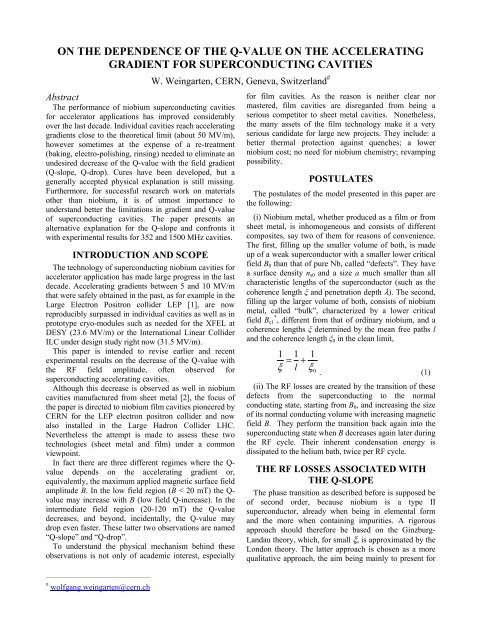

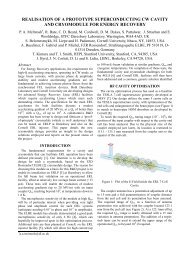
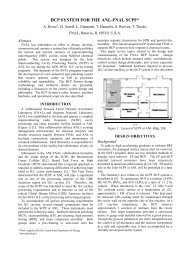
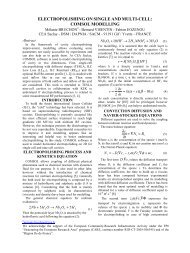

![å¨åæãæç©ä¿æ¤ææå¦ãï¼å¤§äºï¼ââå åºææååºç¨.ppt [å
¼å®¹æ¨¡å¼]](https://img.yumpu.com/42555314/1/190x135/aaaeaaeccaaeaeaea-ai-1-4-aai-1-4-aaa-aaeaeaacppt-a-1-4-araea-1-4-.jpg?quality=85)
